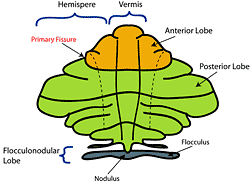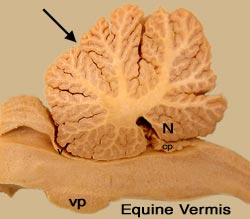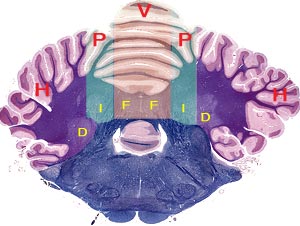Phylogenetic (Functional) Divisions:

The cerebellum can be divided into three divisions based on phylogenetic development. The three divisions have different functional roles that correspond to the different capacities of phylogenetic motor development. Thus, the phylogenetic divisions are functional divisions as well as anatomical divisions.
- Archicerebellum = flocculonodular lobe
This ancient (oldest) part of the cerebellum is designated vestibulocerebellum because it functions like vestibular nuclei. It receives input from the vestibular nerve and it sends output to vestibular nuclei directly or via the fastigial nucleus. - Paleocerebellum = rostral lobe
This so-called old part of the cerebellum is designated spinocerebellum because of its rich afferent input from the spinal cord. Via projections of the fastigial nucleus to the reticular formation, the rostral lobe regulates muscle tone and posture. - Neocerebellum = caudal lobe
This phylogenetically recent component of cerebellum is designated cerebrocerebellum because of its afferent input from cerebral cortex, via pontine nuclei and the middle cerebellar peduncle. It is concerned with coordinating muscle activity, via projections of interpositus and dentate nuclei to midbain and forebrain motor centers.

Longitudinal Divisions:
Based cerebellar cortex connections to the three cerebellar nuclei, cerebellar longitudinal zones (vermis, paravermis, and hemisphere) intersect the above phylogenetic divisions.

Although the longitudinal zone are anatomically based, they also have functional distinctions because the fastigial nucleus projects to the hindbrain, the interpositus nucleus projects to the midbrain, and the dentate nucleus projects to the forebrain.
Thus, two schemes exist for dividing the cerebellum, phylogenetic and longitudinal. You may choose whichever one is the more appropriate for your particular communication circumstances.